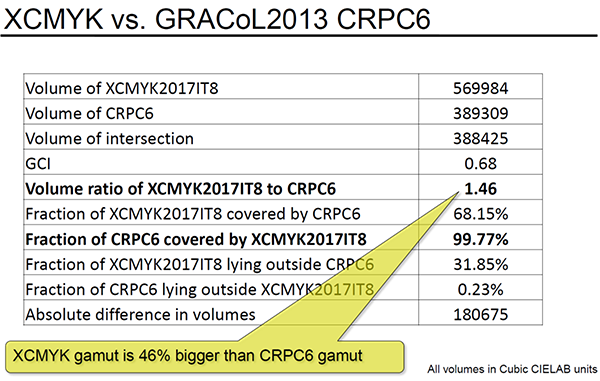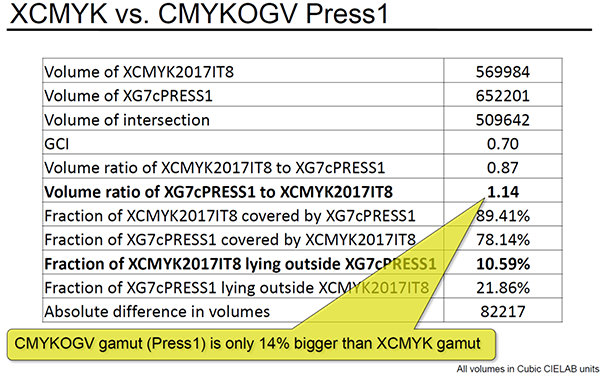Since 2006, GRACoL® has enjoyed enormous success as a worldwide default color space for preparing CMYK files. The combination of GRACoL® and G7® has greatly improved the efficiency and consistency of print production, not only in offset, but also in every printing method like flexo, gravure, inkjet, electrophotography, liquid electrophotography (LEP), screen, and dye sublimation. For many printers and print buyers, GRACoL has become the de facto standard for exchanging CMYK files between one process and another.
The one limitation of GRACoL is that its color gamut is noticeably smaller than that of many new printing processes, which puts GRACoL printers at a disadvantage when maximum color saturation is required. GRACoL is perfect for general commercial printing but falls short of the richly saturated color gamut needed for packaging and high-impact printing.
When more color is needed on press, the traditional solution is to augment the CMYK inks with additional inks and custom ICC profiles under the generic term “expanded gamut” (or “extended gamut”) printing. Unfortunately, this approach lacks the standardization benefits of GRACoL because every expanded gamut system uses its own unique ink colors, software, and ICC profiles, and files made for one system cannot be printed directly on another. This was addressed by the Idealliance Expanded Gamut Project.
The Idealliance Expanded Gamut Standardization Project
The Idealliance Expanded Gamut Project seeks to makeexpanded-gamut printing easier and more efficient by researching and publishing optimized methodologies, ink specifications, and ICC profiles. The goal of the project is to bring at least some of the convenience and easy file interchange already enjoyed by GRACoL to the expanded-gamut market. But first some basic questions had to be answered, such as how many inks are needed, and what color should they be?
CMYKOGV (Seven-Color Expanded Gamut)
Traditional expanded-gamut printing uses up to seven inks—normal CMYK plus (typically) orange, green, and/or violet, hence the generic process name “CMYKOGV.” Optimizing the OGV ink colors was a key goal of the Expanded Gamut Project, but an equally important goal was to determine how the CMYK inks should be printed and augmented. If the CMYK inks are only printed to GRACoL specifications, the full potential of CMYKOGV printing cannot be achieved, because the OGV inks do nothing to expand the gamut in pure cyan, magenta, or yellow areas. To maximize the gamut of seven-color printing, the gamut of the CMYK inks must be expanded independently of the OGV inks, which brings us to the concept of XCMYK, or “eXpanded-gamut CMYK.”
The Idealliance ECG program worked to create an industry standard test chart, methods, and procedures for calibrating, and a target characterization data set for ECG (Extended Color Gamut) printing, which was the world’s first of its kind.
The ECG program will provide the following benefits for the industry:
- Providing a common ECG target for use with a wide range of software
- Providing a calibration methodology
- Providing printing aims and characterization data
XCMYK (Four-Color Expanded Gamut)
XCMYK was a GRACoL committee research program that exploredthe maximum color gamut achievable with just four (CMYK) inks. To date, the thousands of press runs over two-plus years have shown XCMYK printing can consistently yield a color gamut much greater than GRACoL, although not as large as CMYKOGV. In November 2016, Idealliance released the XCMYK profile and announced a new color space or Characterized Reference Print Condition for general industry use,representing XCMYK expanded gamut printing that can be achieved on digital (inkjet, EP, LEP) and offset presses.
XCMYK or CMYKOGV—Which Should You Use?
The XCMYK and CMYKOGV expanded gamut methodsare not competitive, but rather symbiotic, because XCMYK already defines the CMYK gamut of an optimized CMYKOGV color space. XCMYK is simply a more cost-effective stepping-stone whose color space (and costs) lie somewhere between GRACoL and CMYKOGV. So, which should you use?
- If you want the very largest color space possible, and the work merits the cost of extra color units, use CMYKOGV.
- If you want a color space significantly richer than GRACoL but less expensive and complicated than CMYKOGV, use XCMYK, especially if you are printing EP, LEP, or inkjet.
- If you want excellent commercial color printing with maximum file interchange potential, but don’t have the need for expanded gamut, use GRACoL.
Regardless of which system you use, remember that because GRACoL, XCMYK, and CMYKOGV are all based on the same CMYK inks as well as G7, they share many of the benefits that have made GRACoL so successful. These include easier file exchange, standardized ICC profiles, standardized proofing specifications, and standardized workflows.
Many digital devices now can print gamuts that are larger than traditional print standards such as GRACoL. For these devices, simply using XCMYK can produce color that is much more vibrant and appealing. For offset print, XCMYK involves running inks at higher densities and is considered specialty printing. XCMYK provides a significant gamut increase over GRACoL and Fogra. While GRACoL can reproduce about 67% of the Pantone+ library, XCMYK can reproduce about 85% of the Pantone library and the Idealliance ECG (CMYKOGV) can reproduce up to 98% of the Pantone library.
XCMYK is part of the broad ECG initiative from Idealliance moving through domestic and international standardization right now. Currently with ISO/PAS 15339, which are the CRPCs 1-7 (created by Idealliance Working Groups), and additional CRPC (Characterized Reference Print Condition) will be added, CRPC_8 (which will be then formerly known as XCMYK) will meet the unique color demands of inkjet and digital printing. The importance of this color space cannot be overstated as it gives this market a color space, dataset, and profile which meet the demands of our ever-evolving industry, which is the work of Idealliance.
Idealliance’ PPC Working Group has made profiles, datasets, as well as basic information about calibration and profile use available for anyone in the world. To learn more about XCMYK and to download the profiles, datasets, and other information go to www.gracol.org, which is an Idealliance website for quick technical downloads.
XCMYK™ Gamut Analysis














Discussion
Join the discussion Sign In or Become a Member, doing so is simple and free